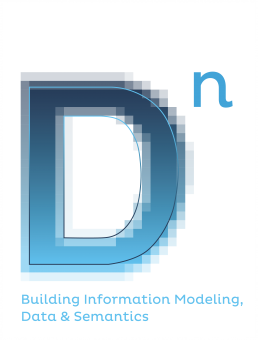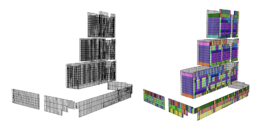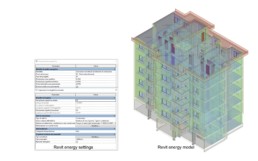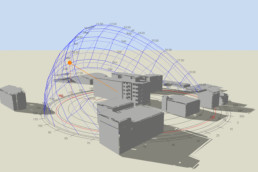Still talking about BIM. Reflections drawn from experiences working on bespoke facades projects
ABSTRACT
Dealing with processes, digital tools and their application in the design and construction of a building means working with many acronyms that identify micro or macro-topics, areas or disciplines and at the same time, perhaps for their very nature, that generate various interpretations and some misunderstandings.
One of the first and most important acronyms, widely spread in the 1980s and then discussed for more than twenty years, is the acronym CAD and its intrinsic dualism between Computer Aided Drafting and Computer Aided Design. This dualism – which can be considered outdated as well as unsolved – was interpreted as Computer Aided Architectural Design (CAAD) and Computer Aided Design and Drafting (CADD) depending to different authors and contexts.
The most recent and popular acronym is BIM (Building Information Modeling). Depending on the context, it can be understood at the same time as a process, as a set of digital tools or as the result of both. In BIM there are many other acronyms subject to interpretations. Just to make an example: LOD (Level of Development) vs. LoMD (Level of Model Definition) that is the integration of LoD (Level of Detail) and LoI (Level of Information). Both now should migrate to LoIN (Level of Information Need). The term “Level” is often used in various ways and it is sometimes misunderstood.
It is what it is.
This trend will pass as many others and we will have clearer ideas in a few years…
This article does not propose definitions, which would stratify uselessly on others and could be the starting point for others again. It does not even intend to provide clarifications on the “BIM thing” which is in continuous transformation.
In this article, the word BIM will appear using italics, and telling what the author learned in recent years, addressing the digitization of information in the processes of design and construction of bespoke facades, built internationally, in very different markets.
Christian Florian, BIM Manager di Permasteelisa S.p.A.
e-mail: c.florian@permasteelisagroup.com
Index Volume 5
INDEX
EDITORIAL
Cettina Santagati, Sandro Parrinello
VPL FOR HBIM LOI ADVANCED APPS
Stefano Brusaporci, Pamela Maiezza, Alessandra Tata
HS – BIM: HISTORICAL SENTIENT – BUILDING INFORMATION MODEL
Federico Mario La Russa
THE INFLUENCE OF THE CONTEXT ON THE ENERGY EFFICIENCY OF A BUILDING, SIMULATED THROUGH A BIM ANALYTICAL MODEL
Alessia Maiolatesi, Alessandro Prada, Paolo Baggio
GAME ENGINE AS HBIM PROPOSAL FOR SMARTPHONE IMMERSIVE VISUALIZATION. THE CASE OF THE ROMAN THEATRE IN SAGUNTO.
Cos-Gayon López Fernando, Cordón Llácer Joan, Anquela Julián Ana Belén
SEMANTIC WEB AND SEISMIC RISK: BEYOND BIM FOR PREVENTION
Adriana Caldarone
SHAPING THE PAST. THE EXPLICIT DIGITAL DRAWING FOR THE DESCRIPTION OF THE ANCIENT ARCHITECTURES
Michele Calvano, Francesca Guadagnoli
To BIM or not to BIM - Editorial Vol. 05
Magazine’s fifth issue analyzes the parametric modeling procedures aimed at the analysis, knowledge and management of cultural heritage through description of case studies and research that propose application examples regarding parametric databases for the documentation of historical heritage. Construction of digital archives, starting from 3D surveys, associated with dynamic, semantic and parametric three-dimensional models, for a protection of the historical architectural heritage, qualifies the development of analysis tools that exploit three-dimensional modeling and technologies for data visualization and management of the complexity of historical heritage.
Different applications of BIM platforms on historical heritage require a reflection on the quality of models that must be able to describe deformations and irregularities of the built architecture. Ability to write down information on models regarding the state of conservation and the performance of a “building machine” in terms of systems and technological infrastructures constitutes one of the most relevant topics and themes regarding the use of these tools in management of buildings.
The sequence of articles proposes an in-depth study of this issue’s subject by addressing various experiments and variations of the parametric models created.
Contribution of Stefano Brusaporci, Pamela Maiezza and Alessandra Tata, entitled VPL for HBIM LOI advanced apps, is focused on the interoperable implementation of H-BIM database with historical news through the use of VPLs.
Federico Mario La Russa’s article about HS-BIM: Historical Sentient – Building Information Modelsproposes a decision support system starting from HBIM based on artificial intelligence mechanisms in which the model is able to “perceive” stimuli and “propose” solutions related to its management and conservation. Relationship between development of an energy simulation model starting from a three-dimensional BIM prototype is addressed in Alessia Maiolatesi, Alessandro Prada and Paolo Baggio’s text about the influence of context on a building’s energy efficiency, simulated through a BIM analytical model.
Game engine and solutions for the use of heritage through smartphones and immersive systems is an interesting aspect for the convergence of development activities. Case study of Roman theater of Sagunto described by Fernando Cos-Gayon López, Joan Cordón Llácer and Ana Belén Anquela Julián describes this possibility of synergy between information systems with pre-eminently technical purposes and possible developments for dissemination processes.
Still with regard to construction of an archive for heritage’s protection with possibility of building a platform on the web, is Adriana Caldarone’s article (Semantic web and seismic risk: beyond the bim for prevention) which deals with knowledge process for seismic risk prevention in resettlements and is aimed at a global understanding of material and immaterial values underlying the training processes of fabrics and building agglomerations. The experience reported by Michele Calvano and Francesca Guadagnoli in contribution Shaping the past. The explicit digital drawing for the description of the ancient architecturesdescribes the experimentation carried out in the archaeological field of parametric modeling through VPL on the Neolithic settlement of La Draga (Girona, Spain).
Sandro Parrinello, Cettina Santagati
SHAPING THE PAST. The explicit digital drawing for the description of the ancient architectures
ABSTRACT
The research aims to describe a positive match between contemporary digital representation techniques and the discipline of archaeology. Specifically, it refers to the experience resulting from the collaboration between the discipline of drawing and the group of archaeologists based at the Universitat Autònoma de Barcelona [1]. The subject represented through parametric modeling for architecture was the Neolithic settlement of La Draga (Girona, Spain).
Michele Calvano, Politecnico di Torino, michele.calvano@polito.it
Francesca Guadagnoli, Sapienza, francesca.guadagnoli@uniroma1.com
The influence of the context on the energy efficiency of a building, simulated through a BIM analytical model
ABSTRACT
The research presented describes the development of an energy simulation model of an existing building and its environmental context, starting from a three-dimensional BIM prototype. Through the parametric analytical model, subsequently converted into a dynamic energy simulation model, the influence of environmental conditions is assessed in relation to the energy efficiency of the considered building.
Alessia Maiolatesi, Alessandro Prada, Paolo Baggio
Università diTrento. DICAM (Dipartimento di Ingegneria Civile, Ambientale e Meccanica)
HS – BIM: Historical Sentient – Building Information Model
ABSTRACT
This research aims to demonstrate how it is possible, starting from a H-BIM model, to develop a decision support system based on Artificial Intelligence in which the model is able to “perceive” inputs and to “propose” solutions related to its management and conservation.
Federico Mario La Russa
Università degli Studi di Catania - DICAR
Game engine as HBIM proposal for smartphone immersive visualization. The case of the roman theatre in Sagunto (Valencia, Spagna).
ABSTRACT
L’evoluzione del BIM può essere descritta come l’implementazione di un modello di informazioni nella realtà virtuale. Questa comunicazione si concentra sui flussi di lavoro specifici generati durante l’intero processo, dalla raccolta dei dati al modello interattivo finale, che consente all’utente di ottenere informazioni da qualsiasi elemento del modello. Questo lavoro è stato sviluppato in collaborazione con la Direzione per i beni culturali della Generalitat Valenciana. L’obiettivo principale del caso di studio è lo sviluppo di un’applicazione per tour di realtà virtuale tramite piattaforme HMD Smartphone nel Teatro Romano di Sagunto. Il software utilizzato per lo sviluppo di app è comunemente utilizzato nel settore dello sviluppo di videogiochi. Inoltre, il software Leica Truview © ha consentito un utilizzo scientifico della raccolta di dati mediante scanner e fotografia, per rafforzare lo studio archeologico e architettonico del monumento e la gestione del suo patrimonio attraverso la catalogazione virtuale.
Cos-Gayon López Fernando, Cordón Llácer Joan, Anquela Julián Ana Belén
Universitat Politècnica de València
Semantic web and seismic risk: beyond BIM for prevention
ABSTRACT
The process of knowledge for the prevention of seismic risk in settlements is aimed at the global understanding of the material and immaterial values underlying the urban fabric’s aggregative processes.The resulting data are rather varied and complex, as well as with heterogeneous formats, so they need a virtuous systematization to be suitable for the exchange of information between the figures involved in prevention activities. In response to these needs, the workflow proposed intends to exploit the qualities of relational databases, and in particular of BIM systems, where parametric models, interconnected according to constructive and ontological rules, are containers of related information, which succeed in to describe, more or less completely, the architectural organisms through the semantic decomposition of the elements that constitute them. However, the limits imposed by current software, especially those concerning the type of information that you can associate with digital objects, impose the need to implement existing procedures through the potential of other systems (VPL and semantic web), thanks to which conjugate complex form’s modeling with the semantic recognizability of the elements and a high Level of Information. The workflow proposed here has as its output a complex hyper-model, which becomes the basis for the development of effective strategies for the prevention and preservation of the vital components of urban centers at risk.
Adriana Caldarone
Dipartimento di Storia, Disegno e Restauro dell'Architettura, Sapienza Università di Roma
VPL for HBIM LOI advanced Apps
ABSTRACT
The HBIM processes require the management of many heterogeneous information, such as historical ones, usually not supported by the apps available on the market. The paper presents the interoperable expansion of the HBIM database through the use of visual programming.
Stefano Brusaporci, Pamela Maiezza, Alessandra Tata
Università dell'Aquila
Reviewer 2019
REVIEWER 2019
Fabio Bianconi, Università di Perugia, Italy
Stefano Brusaporci, Università dell’Aquila, Italy
Michele Calvano, Politecnico di Torino, Italy
Marco Carpiceci, Sapienza Università di Roma, Italy
Domenico D’Uva, Politecnico di Milano, Italy
Marco Filippucci, Università di Perugia, Italy
Elena Gigliarelli, Itabc-CNR, Italy
Carlo Inglese, Sapienza Università di Roma, Italy
Alfonso Ippolito, Sapienza Università di Roma, Italy
Alessandro Luigini, Università di Bolzano, Italy
Giovanna Massari, Università di Trento, Italy
Ivan Paduano, Sapienza Università di Roma, Italy
Leonardo Paris, Sapienza Università di Roma, Italy
Alberto Raimondi, Università Roma Tre, Italy
Michele Russo, Sapienza Università di Roma, Italy
Mario Sacco, BBIM Expert, Italy
Alberto Sdegno, Università di Trieste, Italy
Valeria Zacchei, PhD BBIM Expert, Italy










